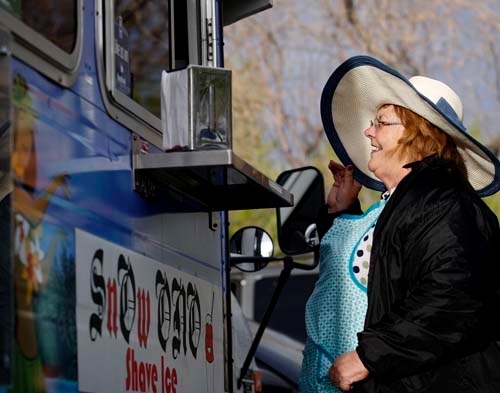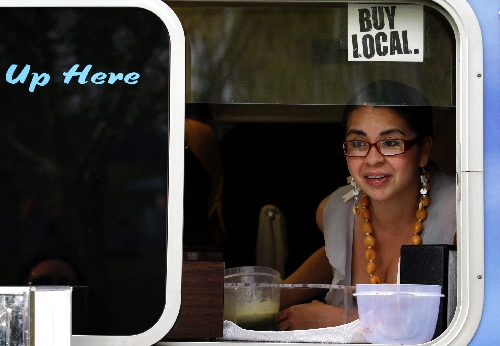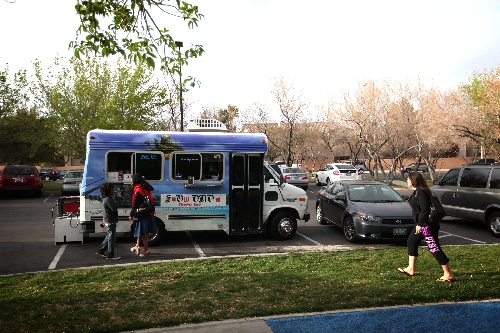Food trucks don’t smell right to some valley restaurants
After Jon and Marianne Yoffee won about $35,000 on the "Wheel of Fortune" game show, they decided to take a spin on the road to financial independence by investing in their own food truck business.
They say the shave ice truck they wheel around Las Vegas has been a hit, especially with displaced Hawaiians eager for an authentic taste of their island homeland.
"We pretty much used all our life savings," said Marianne, 29, of the decision to create Snow Ono Shave Ice. "There are a lot of Hawaiians in Las Vegas; they want the real deal."
While the couple was confident enough in the product to gamble their nest egg, they didn't bet on the city -- whose leaders regularly proclaim they're seeking to embrace young, innovative entrepreneurs -- would propose new regulations that could spin Snow Ono and other food truck vendors closer to bankruptcy.
But that's what's happening in city government, where the Planning Commission narrowly approved a regulation that would prevent food truck operators on public streets from setting up shop within 1,320 feet of an existing brick-and-mortar restaurant.
"It really made me upset, honestly," Marianne said of the proposed regulation. "There are all these restaurants that are right next to each other. What's the difference if a food truck is close to a restaurant?"
The proposed regulations aren't yet official, and there's still plenty of time for City Council members to reduce the buffer zone; but the prospect of parking no closer than a quarter-mile to existing restaurants has food truck owners worried their burgeoning businesses could end up in the ditch.
"That is just ridiculous. You wouldn't be able to have a food truck anywhere. "I don't know what they were thinking," Douglas Porter, a former restaurant owner who owns Curbside Cafe, a gourmet burger food truck, said of the Planning Commission decision.
THE DECISION
The decision to propose a blocks-long buffer between food trucks and existing restaurants happened March 13 during a meeting of the Planning Commission, but has been in the works for months.
It can be traced back to disputes in the city's Arts District, where supporters of existing restaurants had begun complaining that food trucks were parking too close and poaching business.
The friction prompted officials to see if they could broker a regulatory truce between restaurants, some of which had been open for decades and are seen as critical to thriving arts and entertainment scenes, and food trucks, which in their current, upscale form are relatively new to the Las Vegas area.
What emerged from that process, which included restaurateurs, food truck operators and city officials, was a raft of new regulations that included a proposed 150-foot buffer zone and other changes friendly to the trucks, such as the ability for as many as two trucks to park up to four hours in one place. The existing limit is 30 minutes, although it is not always enforced.
Trucks that are part of a permitted event, such as Vegas Streats or First Friday, aren't subject to the proposed distance requirement. Clark County has no distance requirement for food trucks.
But when the proposed ordinance went to the Planning Commission, restaurant owners from the Fremont East entertainment district showed up to press for a wider buffer.
"During the week we are very slow," said Maria Calvino, who along with her husband, Jose Calvino, owns Mamita's restaurant. "The weekend is when we make our money. Then all these vendors come in and take part of our revenue, and I don't think it is fair."
In written testimony to the commission, the Calvinos said an angry food truck vendor smeared grease on their restaurant window. They said restaurants pay thousands of dollars in rent and have been struggling to survive downtown until recently, as redevelopment efforts start to bear fruit in the form of more foot traffic. They resent the food trucks for capitalizing on the new business at the expense of restaurant owners who survived the bad times.
"Instead of leaving when the special events are over, they stay over and take our business," Maria Calvino said.
Planning Commission Chairwoman Vicki Quinn credited the restaurant owners for showing up and persuading the members to dramatically widen the proposed buffer zone.
"Had we not heard from you, we would not have known," Quinn said of the restaurants' problems with food trucks. "I thank you for taking a stand."
Others on the commission disagreed. Commissioner Trinity Schlottman cast one of two votes against the proposed regulations.
"The food truck ordinance was fine as proposed with the 150 (foot) distance separation," Schlottman said in an email. "If you increase the distance separation up to 1,320 (feet) from any bricks and mortar establishment, it would eliminate all food trucks from downtown, at least in the right of way."
FIGHT MOVES FORWARD
Now the proposal moves on toward the City Council.
It's likely to land on an upcoming agenda for the city's Recommending Committee, which consists of two council members who scrutinize proposals before they go to the full council.
The committee can modify recommendations before forwarding them. The council can approve, reject or amend any portion it sees fit.
City spokesman Jace Radke said Mayor Carolyn Goodman expects the proposed regulations will be subject to further debate.
"She has asked that all sides of this issue be heard as this proposed ordinance moves through the process," Radke said in an email. "She was very pleased that there was a good discussion at the recent Planning Commission meeting. She expects that there will be additional input from the public and she is hopeful that an ordinance can be crafted that works for both food truck operators and restaurants."
Contact reporter Benjamin Spillman at bspillman@reviewjournal.com or 702-229-6435.
























